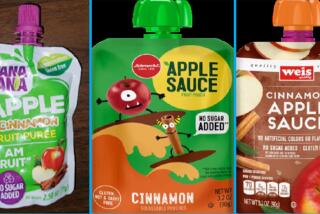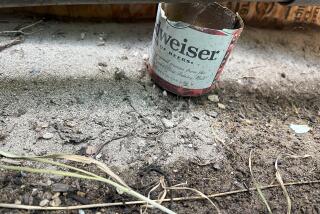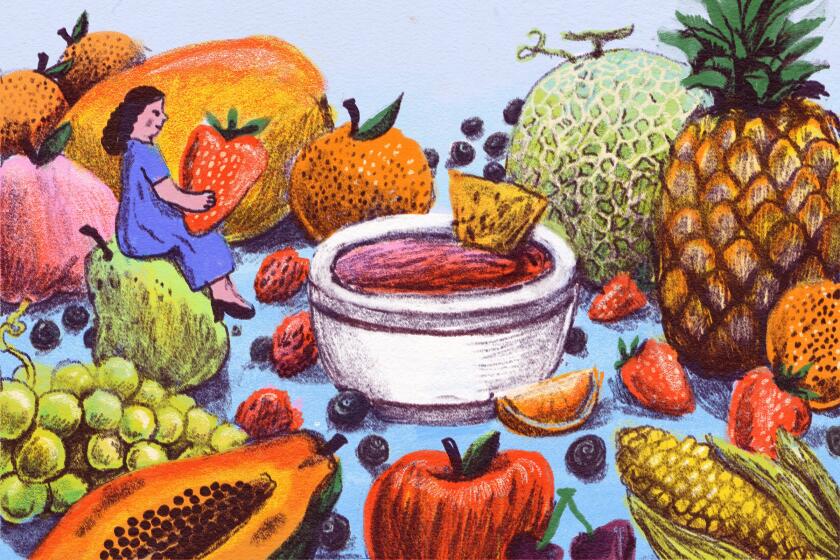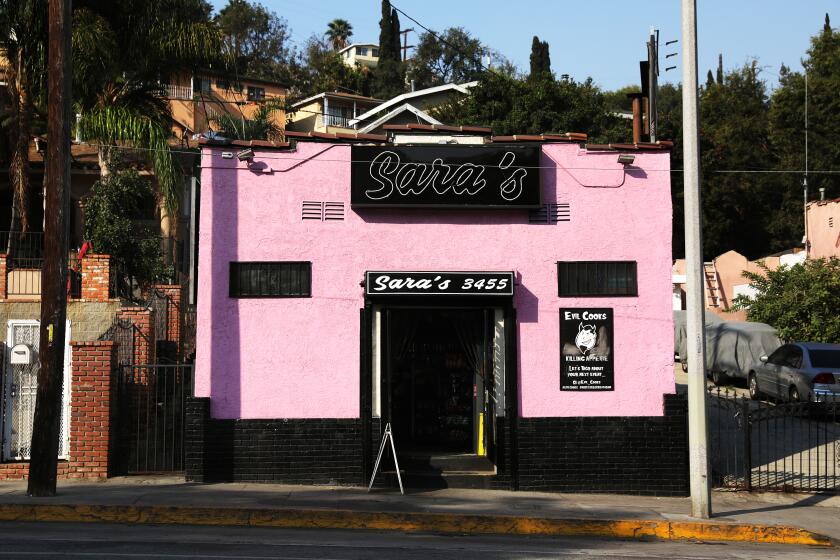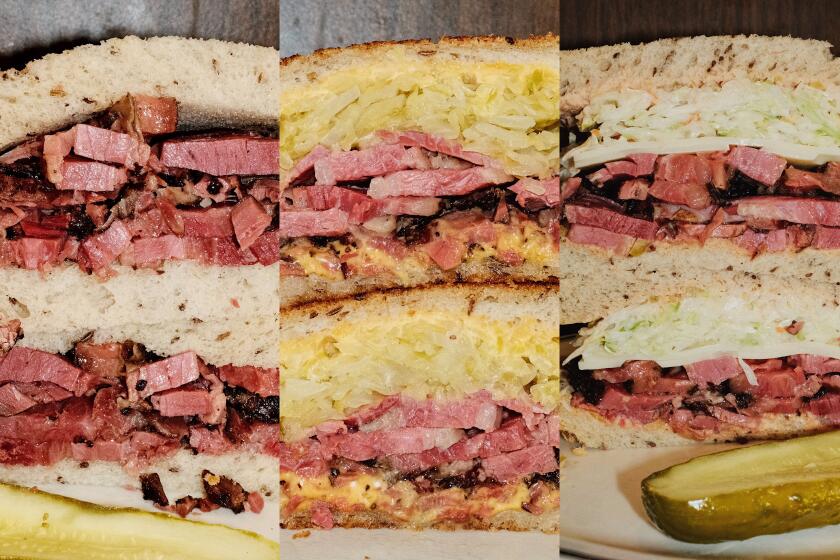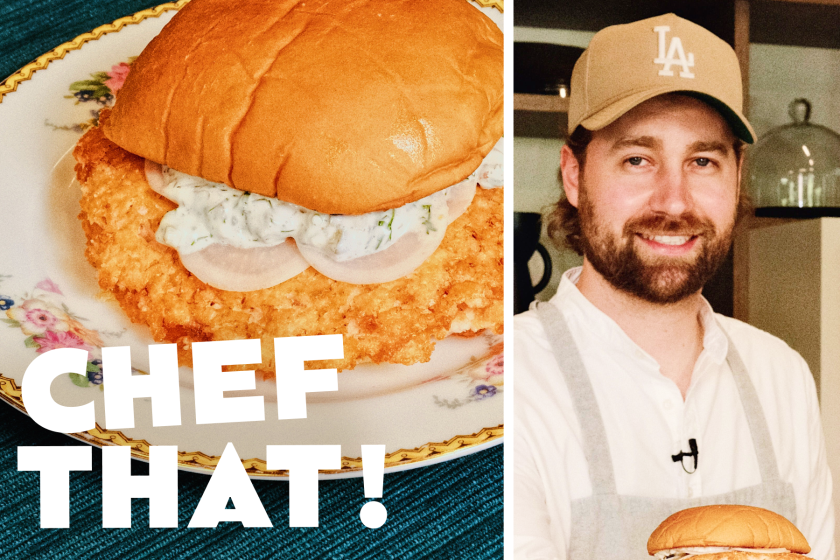Farmers Markets: A refresher course on specialty apples
Commercial apple varieties mostly lack the intensity, complexity and idiosyncrasies of the finest older and specialty kinds, for which the prime season has just begun. It’s a good time to review the most flavorful varieties that will be available at local farmers markets over the next few months.
Many of these varieties have commercial flaws such as cosmetic blemishes, susceptibility to diseaseand low productivity that explain their rarity at supermarkets. In addition, commercial growers and chain stores seem to prefer varieties that appeal to the lowest common denominator, afraid that any apple with too distinctive a flavor will discomfit some customers.
Farmers markets, where vendors can offer samples and schmooze with buyers, are the ideal venue for specialized produce such as super-flavorful apples. The problem is, most of the varieties below are adapted to cooler growing conditions than are generally found in Southern and Central California, but there are a few exceptions.
Growers can gain enough of the winter chill that most older apple varieties need by planting at higher elevations (Tehachapi, Cuyama) or in low areas where cold air collects (Paso Robles). A few maritime zones, such as San Luis Obispo and Watsonville, have the best of both worlds, just cool enough in winter, with sufficient warmth in summer.
Many modern commercial varieties such as Gala and Fuji have triumphed because they flourish in a wide range of growing conditions. Many heirloom apples are more particular, even within a favorable growing area, says Michael Cirone, who raises several dozen varieties in See Canyon in San Luis Obispo.
For example, “Yellow Bellflower thrives on a really prime, well-drained loam, but doesn’t grow well on marginal clay soil,” he says. “Old-timers paid attention to the exact location of particular varieties.”
His crop this year is average in size but will come on “fast and furious,” adds Cirone, because his trees, which are dry-farmed, are coping with a second year of low rainfall. They are ready to release their fruit, rather than letting them hang on for an extended harvest, so individual varieties may come and go quickly at his stand at the Santa Monica Wednesday and Saturday Downtown farmers markets.
Windrose Farm of Paso Robles, which planted in the late 1990s on the advice of Terry and Carolyn Harrison of the old Sonoma Antique Apple Nursery, is the other leading vendor of rare and specialty apples, at the Santa Monica Wednesday and Hollywood markets. (The nursery, now known as Trees of Antiquity and based in Paso Robles, is still the best California source for heirloom apple trees.) The owners, Barbara and Bill Spencer, make some of their varieties available from storage for a few weeks after harvest.
Cuyama Orchards is primarily a commercial producer, but it has also planted several heirloom varieties to appeal to its farmers market clientele. Currently, it’s at the Torrance Saturday, Mar Vista and Culver City markets, and it’ll start at several Santa Monica markets later in September.
The varieties below are listed in order of approximate harvest dates, along with sources. Gravenstein, the quintessence of high flavor, is excluded only because its season (last week of July and August) is almost over.
Cox’s Orange Pippin. The preeminent English dessert apple, with tender, yellow high-flavored flesh. Generally not well adapted to California — it drops before ripening — but in some years, Cirone and Windrose produce perfect specimens, in late August and early September. (Its seed parent, Ribston Pippin, is just as intensely flavored, but in California it develops a physiological disorder called water core, along with off flavors. It’s still worth trying, from Cirone, who hopes the trees will be less problematic as they mature.)
Golden Russet. A specialty of upstate New York, from the 18th century. Ideal specimens are golden bronze with a bright coppery orange cheek. Fine-grained, exceptionally sweet flesh tastes like cider. It really prefers a cooler, more humid climate, so it’s hard to find at its best south of Watsonville. Cirone and Windrose, late August and September.
Esopus Spitzenburg. A classic early American variety, reputed to be Thomas Jefferson’s favorite, with juicy, sprightly yellow flesh and rich flavor. Its characteristic scarlet color is lighter in warmer areas. It’s very vexing for farmers, because it is susceptible to fire blight, and its branches grow insanely akimbo. Cirone and Windrose, September and early October.
Ashmead’s Kernel. Small and partially russeted, this English antique (raised by Dr. Ashmead, a physician from Gloucester, England, about 1700) looks unimpressively small and scruffy, but packs a powerfully rich, complex flavor reminiscent of pear drops. It’s almost too intense for casual munching. Available from Cirone and Windrose, from early or mid-September.
Calville Blanc d’Hiver. A classic French dessert and culinary variety from the 16th century, ideal for tarte tatin. It’s pale green with prominent ribs and a distinctive effervescent flavor that evokes citrus. And it should be stored a month or more to develop its best flavor. Windrose (mid-September), and Cuyama Orchards (October).
Newtown Pippin. It’s large, light green, lopsided, with russet in stem cavity; it has a firm, crunchy flesh with a perfect balance of sweetness and acidity, and complex, lingering flavor. It originated in the early 18th century in Newtown, N.Y. (now in Queens), but it reaches perfection in Watsonville. It’s still produced commercially in the Northwest, but there it is harvested underripe to emulate Granny Smith (a crowning indignity for the noble Pippin!). It keeps firm and improves in flavor for months. Cirone (mid-September) and Cuyama Orchards (October).
Kandil Sinap. It’s an oddly elongated, conical variety with creamy yellow skin and a red blush; it has snow-white flesh, and is crisp, juicy and sweet with rich flavor. It originated in Turkey or the Crimea in the early 1800s. Recently planted by Cuyama Orchards; October.
Sierra Beauty. The most celebrated apple of California origin, discovered circa 1890 in the Sierra Nevadas. It has a greenish-yellow skin overlaid with pink and red; its flesh is firm, crisp, juicy, fine-textured and richly flavored. Cirone (crop failure this year) and Windrose, October on.
GoldRush. The most flavorful modern variety, bred for disease resistance, but it has a dense, crunchy flesh with intense, sweet-tart taste and Golden Delicious aromatics. The best specimens are deep yellow. Keeps well. Cirone, mid-October on.
Hauer Pippin. It’s an ultra-late-season apple, harvested in late October and November, and it keeps for months. Its yellowish-white flesh is juicy, very sweet, with clove flavor. It’s a seedling of Cox’s Orange Pippin and Yellow Bellflower, from Aptos, 1890. Windrose and Cirone.
New apple book
“Apples of North America,” just published by Timber Press, the long-awaited masterwork by America’s greatest apple expert, Tom Burford, is an invaluable resource for lovers of flavorful and historic apples. Burford’s family has grown apples in the Blue Ridge Mountains of Virginia since 1715, and he describes 192 exceptional varieties from a lifetime’s experience.
He includes well-known heirlooms still widely grown today such as McIntosh, Winesap and Northern Spy; worthy rarities that he and other enthusiasts have rescued from oblivion, such as Caney Fork Limbertwig and Cannon Pearmain; and a few modern varieties, valuable for their disease resistance and good flavor, such as Pristine and Priscilla. For each variety he provides a gorgeous photo, alternative names, history, descriptions of the fruit and tree, disease resistance, uses and storage quality. There is also a primer for home garden and specialty growers, with advice for planning an orchard, propagation, planting and growing practices.
They no longer make Southerners like Burford, who just turned 78. In person, he speaks in a delicious drawl, with a courtly manner, and a hint of a wild gleam in his eye when the subject turns to apples. The prose of his book is infused with the felicities of his speech, as he tells how his family prized cider made from Newtown Pippins as “Sunday Cider,” or how Ben Davis was given the deprecating nickname “cotton apple.” Let us hope that, as he promises, he will soon make a rare foray to Los Angeles to promote his book.
More to Read
Eat your way across L.A.
Get our weekly Tasting Notes newsletter for reviews, news and more.
You may occasionally receive promotional content from the Los Angeles Times.

